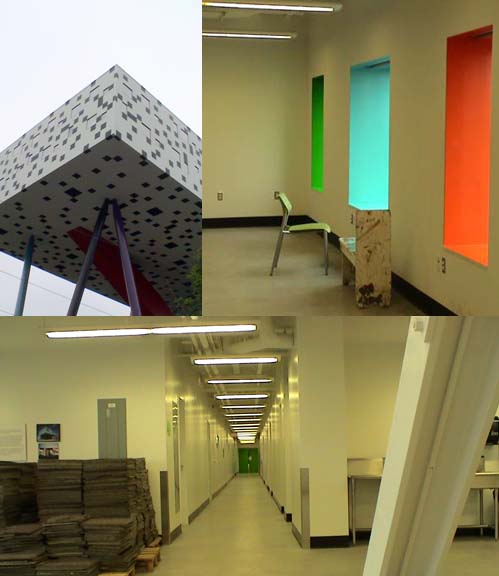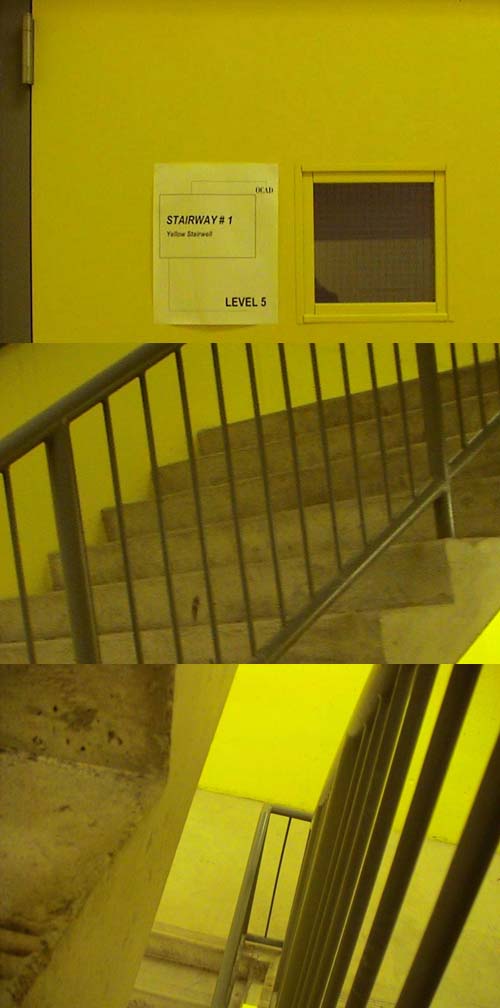
|
Lorna Mills and Sally McKay
Digital Media Tree this blog's archive OVVLvverk Lorna Mills: Artworks / Persona Volare / contact Sally McKay: GIFS / cv and contact |
View current page
...more recent posts
Just found out that one of my favourite books, Laddders by Albert Pope, has a great website with diagrams and animation.
cyborg notes:
I've been reading a collection of essays by Critical Art Ensemble called Flesh Machine (available here in PDF format). The essay titled "Posthuman Development in the Age of Pancapitalism" is pretty useful for thinking about cyborgs and the horrible paradoxes between utopic/dystopic versions of where we might be headed with this whole cerebral web-based interconnectedness thing. The essay was written in 1998 (I think, have to check because it could be earlier) and talks about Virtual Reality (VR). Remember when goggle headsets seemed exotic and full of promise? (goggle => => => google {heh heh...don't mind me}) CAE has this to say:
VRís primary value to the ISA [Ideological State Apparatus] is not as a technology at all, but as a myth. VR functions as a technology that is out on the horizon, promising that one day members of the public will be empowered by rendering capabilities which will allow them to create multisensual experiences to satisfy their own particular desires. The mysterious aura constructed around this technology associates it with the exotic, the erotic, and potentially, with the ethereal. By perpetuating the myth of a wish machine that is always about to arrive, the pancapitalist ISA builds in the population a desire to be close to image technology, to own it. Unfortunately, most technology is being designed for precisely the opposite purpose from that of a wish machine, that is, to make possible better control of the material world and its populations. This combination of myth and hardware sets the foundation for the material posthuman world of the cyborg.It's a good idea to remember that the promise of populist egalitarian empowerment is an early symptom of ultimately oppressive technological developments. Ursula Franklin had some good stuff to say on this relating the advent of cars to the advent of computers, and as soon as I find the book (too many piles) I'll post some of it. In the meantime, CAE* is sounding pretty grim on the topic of the future.
The current spectacle of technology is having an effect on the civilian population of the appropriate classes, although cyborg development in this sector is a little more subtle than in the military. Most people have seen the first phases of the civilian cyborg, which is typically an information cyborg. They are usually equipped with lap-top computers and cellular phones. Everywhere they go, their technology goes with them. They are always prepared to work, and even in their leisure hours they can be activated for duty. Basically, these beings are intelligent, autonomous workstations that are on call 24 hours a day, 365 days a year, and at the same time can be transformed into electronic consumers, whenever necessary. In this phase of posthuman development, the will to purity, explicit in the spectacle of anxiety, manifests itself in two significant forms: First is the purification of the pancapitalist cycle of waking everyday life.* in case you hadn't noticed these guys are currently stuck deep in patriot-act-style doo-doo and need some help.
Cyborgs are reduced to acting out rational, pragmatic, instrumental behaviors, and in so doing, the cycles of production (work) and consumption (leisure) are purified of those elements deemed nonrational and useless (by the pancapitalist system). It seems reasonable to expect that attempts will be made to reduce or eliminate regenerative, nonproductive processes like sleeping through the use of both technological and biological enhancement. The second is a manifestation of ideological purity which persuades the cyborg to obsessively value that which perpetuates and maintains the system, and to act accordingly. The prime disrupter of this manifestation of purity is the body itself with its endlessly disruptive physical functions, and the libidinal motivations inherent in human psychology. Hence technological advancement alone will not create the best posthuman; it must be supported by developments in rationalized body design.
Despite my generalised crankiness about Superbuild (wacks of provinicial dough handed over to Toronto's biggest cultural institutions to hire architects and make some buildings), Will Alsop's art-school-in-the-sky has won me over. I'm slow to take to trends, and the Cindy Lauper-look revival intially struck me as a bad idea. Today, however, it's looking fine. You'd never guess it from the drawings, but the street presence of this thing is unostentatious and charming. Many many thanks to Selma for pointing me to this essay by Hugh Pearman in which (among many other things) he praises Torontonians for our friendliness. Hah. But he was hanging out under this building which does have an infectious friendly presence; just dorky enough that you let down your guard, solid enough that you don't feel threatened, graceful enough that you concede a modicum of respect. Earlier today I snuck inside for a look.

Pearman complains:
The two floors in that pixilated tabletop are carved up into cellular spaces - a college requirement, diametrically opposed to Alsop's own preference for something more akin to a giant open-plan creative playpen. So there is no great internal view.Ouch - as someone who attended an art school and retained a shred of dignity, I object to that 'playpen' comment. Part of the reason I first objected to this building was it's message of "hey art is kooky" when there's many other things I hope for art to be besides wacky and fun, and many such critical and rigorous aspirations that I would hope be imparted to art students, even if they are ensconced in checkerboards in the sky. Thank goodness the big block is functional, and as I crept around today with my camera I passed lots of open classroom doors with lectures going on inside, lockers, storage, places to sit and work, etc. No playpens in sight thank goodness.

There are big panels of solid colour here and there, doors, window frames, etc., that are assertive but not wacky. The windows are really lovely and the view is pretty nice if you care for that sort of thing (Toronto from above). My favourite/least favourite element was "Stairway #1: Yellow Stairway" which is painted in unrelenting cadmium yellow floor-to-ceiling the whole way down the elevator shaft. I thought I'd walk it, for an adventure, but only made it down two flights before I got too spooked and ran back up. It was extreme in a fun way, a very unusual, immersive, trippy stairwell that reminded me of playing Splintercell.

On the downside, the doors to the angled stairway (that red, penile rhomboid you see from the outside) were closed and blocked off with caution tape. Also, the door on one of the elevators was broken and it wouldn't run. These two things made me a bit nervous and I was glad, when I got back to street level, that I don't work in there, despite the elegance, functionality, and lovely colours. Also I glimpsed one of my friends talking in front of a class - strEssful. Much more so than creeping around with a digital camera and writing posts for blogs.